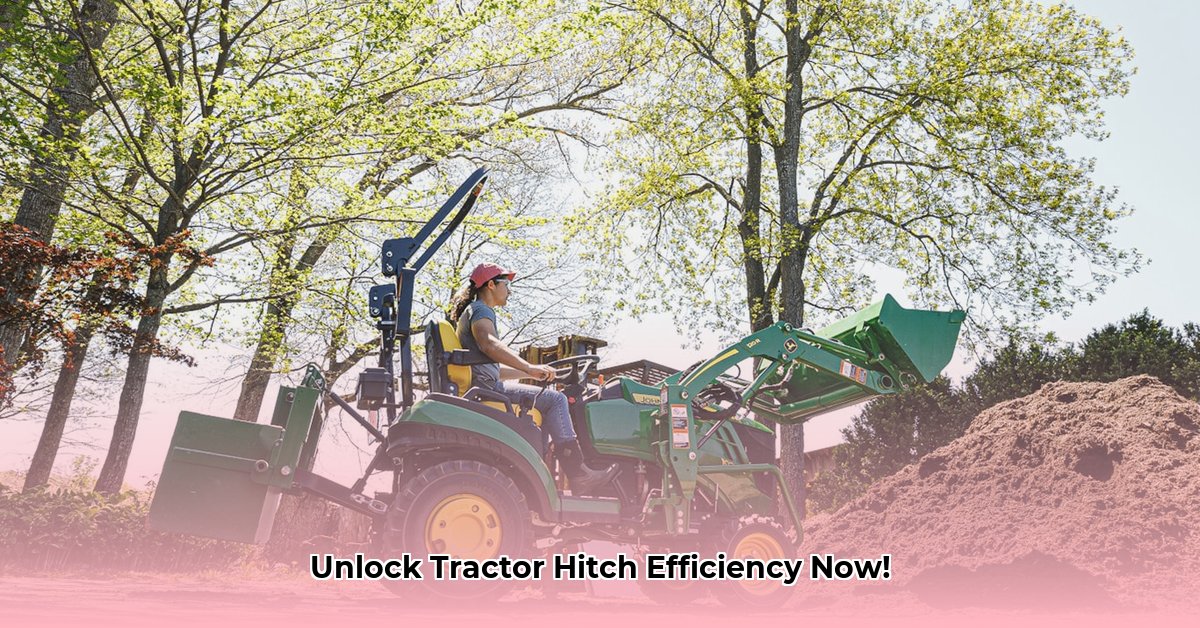
Getting the most from your Class 1 tractor hinges on understanding its three-point hitch. This guide provides step-by-step instructions for selecting and using implements safely and effectively. Whether you're a seasoned farmer or just starting, this guide will help you master your Class 1 tractor's capabilities. For more in-depth information, check out this helpful resource on three-point hitches.
Understanding Three-Point Hitch Categories: Matching Tractor to Implement
Three-point hitches are categorized (0-4) based on tractor horsepower and implement size. Choosing the right category is crucial for safety and efficiency. Mismatched equipment can damage your tractor or cause accidents. This guide focuses on Category 1, common on smaller tractors.
This table summarizes the categories:
| Category | Approximate Horsepower Range | Pin Diameter (inches) | Lower Hitch Spacing (inches) | Typical Implement Examples |
|---|---|---|---|---|
| 0 | Under 15 | 0.75 | 16-18 | Small cultivators, tillers |
| 1 | 15-35 | 1 | 18-20 | Mowers, small plows, seed drills, smaller implements |
| 2 | 35-60 | 1.125 | 20-22 | Larger plows, harrows |
| 3 | 60-120 | 1.375 | 24-26 | Large cultivators, planters |
| 4 | Over 120 | 1.75 | 26-28 | Heavy-duty implements, large equipment |
Important Note: Some Class 1 hitches are "limited," meaning their weight capacity is lower than standard Category 1 hitches. Always consult your tractor's manual. Isn't it striking how much a seemingly small detail like "limited" can impact your work?
Selecting Implements for Your Class 1 Tractor: A Step-by-Step Guide
Choosing the right implements is vital for both safety and efficiency. Here's a step-by-step process:
Consult the Owner's Manual: Your tractor's manual details its hitch's capabilities. This step is non-negotiable. Have you ever skipped this step and regretted it later?
Weigh Your Options: Determine the implement's weight and dimensions. This information is usually found on the implement or its documentation.
Match the Weight: Ensure the implement's weight is within your tractor's maximum lifting capacity. Never exceed this limit. It's important to understand that exceeding weight limits significantly increases the risk of equipment damage and or accidents. This is critically important for safety!
Category Check: Verify the implement's category matches your tractor's hitch (Category 1).
Pinpoint the Right Pins: Use the correct size hitch pins. Secure them properly to prevent accidents. This often-overlooked step is crucial for preventing disasters.
Careful Connection: Follow the instructions for attaching the implement. Ensure proper alignment.
Test and Adjust: Raise and lower the implement to ensure smooth operation. Adjust as needed. Don't move on until you are certain your implement is functioning as intended.
Safety Precautions: Prioritizing Safety on the Farm
Safety is paramount. Never exceed your tractor's limits. Always use the correct hitch pins. Conduct routine inspections of your equipment.
Here's a risk assessment matrix:
| Risk | Mitigation |
|---|---|
| Overloading Your Tractor | Only use implements within your tractor's weight limits. |
| Implement Malfunction | Regularly maintain and inspect equipment. Replace worn parts. |
| Insufficient Lifting Power | Verify both tractor and implement weights before attachment. |
| Incorrect Hitch Setup | Follow manufacturer's instructions precisely. |
| Inadequate Operator Knowledge | Obtain professional training before operating. |
Troubleshooting: Addressing Common Issues
Many problems stem from using the wrong implement or hitch malfunctions.
Implement Won't Lift: Check hitch pins, hydraulic fluid levels, and weight capacity.
Unstable Hitch: Ensure everything is aligned and secured tightly.
Sheared Pin: This indicates overloading. Stop immediately and reassess.
Regular maintenance prevents many of these issues.
Further Resources: Continuing Your Learning
Consult your tractor and implement manuals. Agricultural extension offices and equipment dealers offer valuable support. Online communities provide further avenues for learning and knowledge sharing. Remember, continuous learning is key to long-term success and safety.